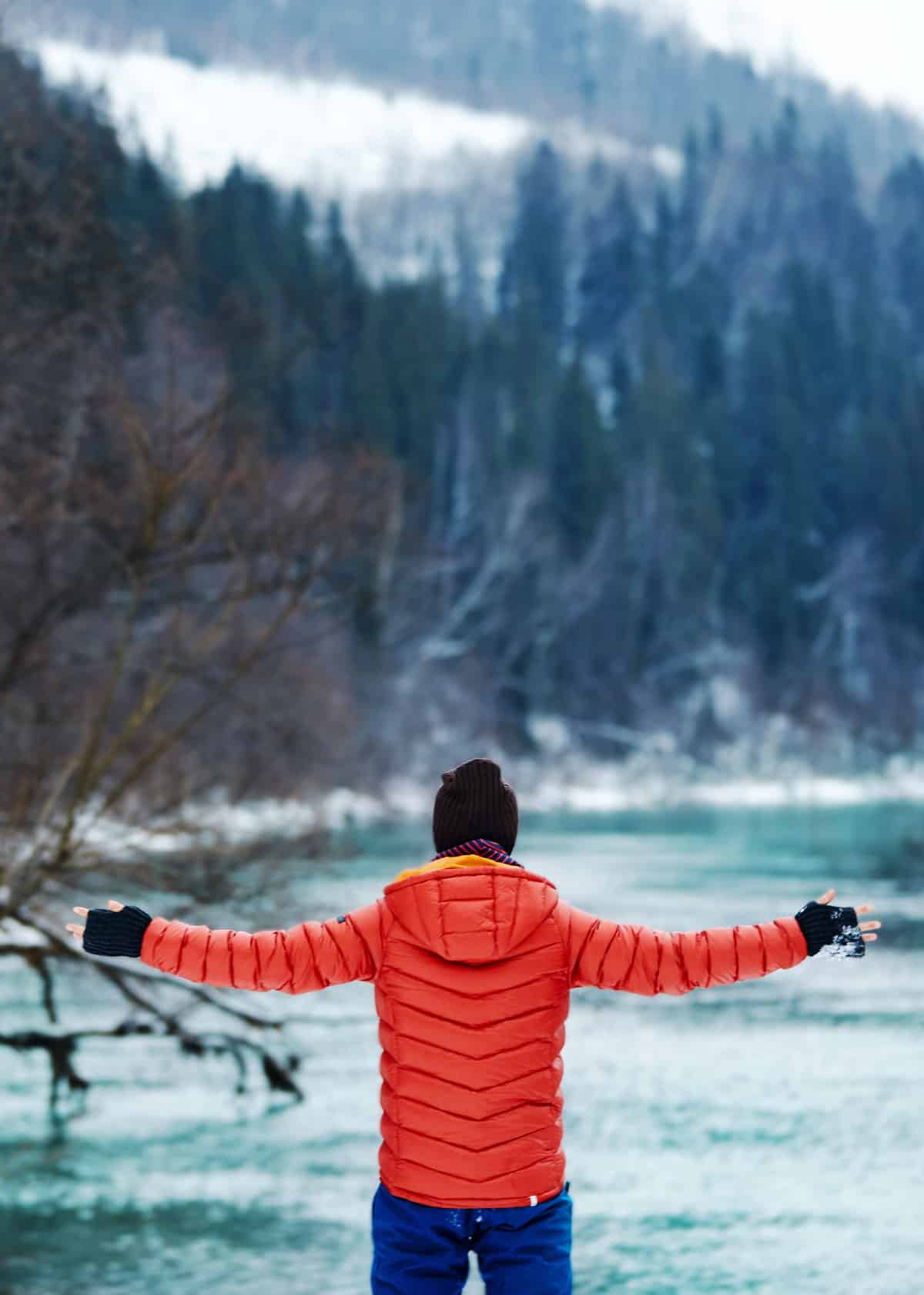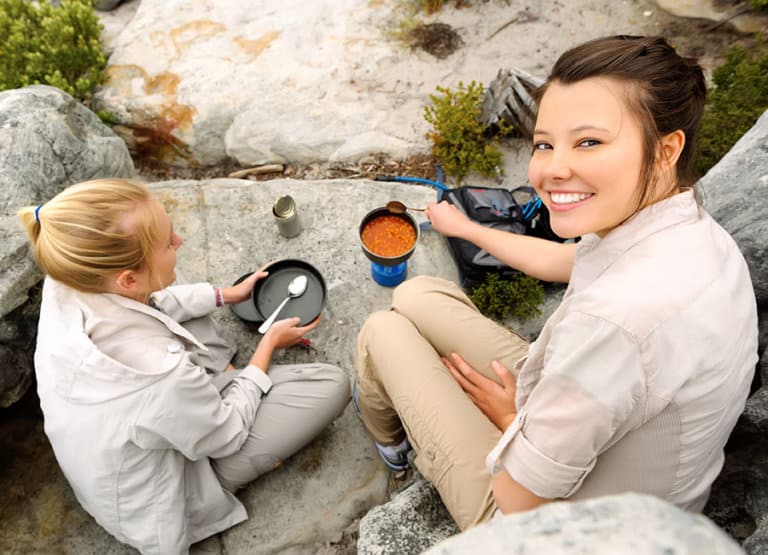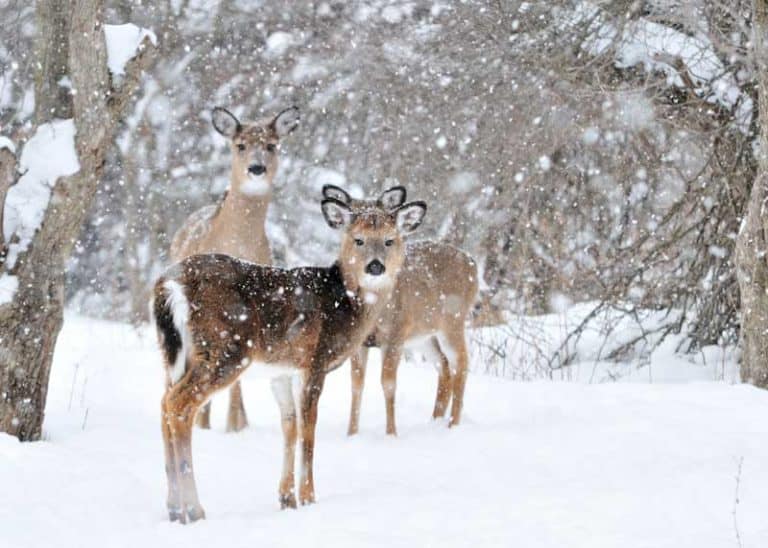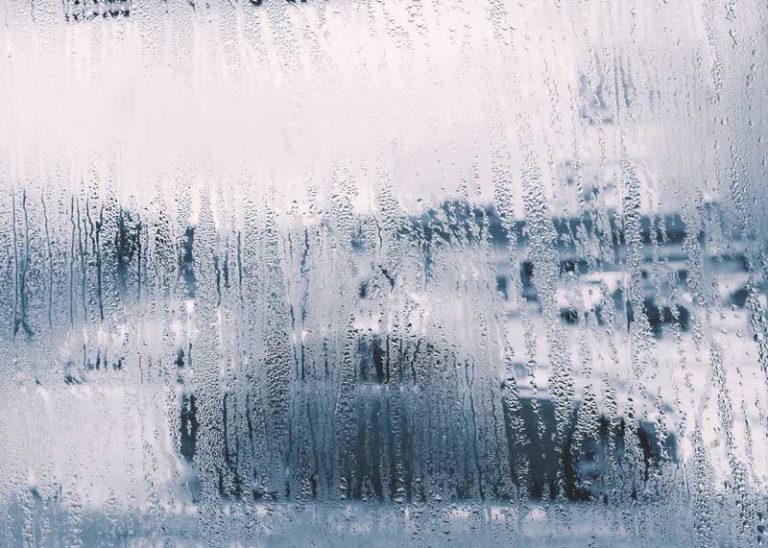Winter Hammock Camping Guide: 23 Cozy Tips and Gear
Heading out for a weekend of winter hammock camping? Very nice! Here are 14 practical tips to help you stay warm and safe. You’ll also find a 9-piece gear list to make your winter hammock camping trip more comfortable.

Here are some general winter camping tips for freezing temperatures.
Guide to Winter Hammock Camping
Camping during winter can be glorious. The wilderness and forests having lost their leaves open up allowing you to see more wildlife, and the snow-covered landscapes are dazzling.
Here’s a glimpse of a winter hammock camping setup by Amanda Bess for the Appalachian Trail.
It’s no longer just the adrenaline junkies and hard-core hikers, more and more of us are enjoying the trails and parks year-round and camping in winter.
We’ve compiled a list of great tips and gear to aid you along your way to winter hammock camping fun and get you out there to enjoy the great outdoors this winter.
So let’s get down to it.

Check out our full Guide to Winter Camping
14 Winter Hammock Camping Tips
The following tips are specifically for cold-weather hammock camping. For more general skills, check out our Ultimate Guide to Hammock Camping.
1. Layer your clothes
This is pretty important. Having numerous layers allows you to increase/decrease the temperature inside your hammock setup.
You might want more layers when you first get in, but as you warm up the sleeping bag, you can remove a layer or two so you are comfortable and avoid sweating.
2. Preheat your sleeping bag with a hot water bottle
This is pretty easy to do. After you cook your supper, put some water on to boil.
Once it heats up, pour it into your metal water bottle then toss it into your sleeping bag. It will be toasty when you’re ready to go to sleep.
A few notes: Be careful about melting your bottle and other plastic bits. Don’t burn yourself. A single-walled metal bottle will cook your skin pretty quick.
Make sure that your bottle doesn’t leak around the mouth. Nothing is worse than a wet sleeping back in the winter.
3. Watch out for snow-filled branches
The excessive weight of the snow and ice can weaken the integrity of the branch – it could break unexpectedly – dropping its snow load on a dozing hammock camper.
4. Choose your site carefully (avoid wind)
Look for natural windbreaks, like trees, rocks and natural topography. Avoid setting up on the edge of a clearing, as the wind can pick up across open areas. Rather, go a little deeper into the woods.
If you can’t find natural shelter, you can create your own with a vertically hung tarp.
5. Get a hammock compatible sleeping bag
These sleeping bags are specially made to wrap around the outside of the hammock.
This will keep you warmer (no compressed insulation) and more comfortable (no bunching and twisting). Hyke and Byke makes a hammock-compatible, down-filled sleeping bag rated to 0ºF (-18ºC).
6. Use an underquilt
If you hate being cold, you might consider an additional layer of insulation. An underquilt mounts on the underside of the hammock.
7. And an emergency, reflective sleeping bag
At just 5 ounces, this is a simple addition to your sleep setup. The reflective material allows you to retain your radiant body heat. It is both wind and waterproof.
Rather than getting inside of the sleeping bag (unless you’re experiencing hypothermia), you can use this as liner in the bottom of your hammock.
8. Store your boot liners and clothes inside the sleeping bag
This accomplishes two things: Your clothes will be warm and dry in the morning.
And your stuff will fill in the empty space at the bottom of your bag – helping to keep you even warmer.
9. Don’t hesitate to head back
Especially for your first winter hammock adventure, it’s probably best not to venture to far from home (or your car).
If the weather changes and you get a chill you can’t shake, there’s no shame in heading back. But there IS shame in staying put and freezing into a popsicle.
Some campers even set a temperature threshold that will decide for them that they should head home.
10. Hang a tarp above the hammock
A tarp is always a good idea in a hammock. But in the winter, it’s even more important. It will help keep you dry and warm.
Not only does it trap heat – it also shelters you from the wind. For the winter, you’ll want to rig it as low as possible.
11. Don’t forget your toque (you know, your beanie)
Your toque (Canadian high fashion) will keep you warm all day and all night. It’s a good idea to take it to bed – you might not need it, but odds are that you will.
While there are lots of synthetic materials available, I recommend merino wool for your night beanie.
12. Use a makeshift pillow
If you don’t use a mummy-style sleeping bag, you’ll need some type of a pillow. Otherwise, your head will be directly on the nylon hammock. A folded sweater, towel, or anything with insulation value will do.
Inflatable pillows are not a good idea for this application – they have zero insulation value.
13. Think about a pee bottle
I know – pee bottles are gross and you don’t want to use one. That’s fine. If you hate this idea, just skip to the next section.
But just imagine how unhappy you would be to climb out of your warm sleeping bag – into the cold, dark night to go pee.
And cold temperatures have a way of making us go more often.
You have a few options:
- Men can use a water bottle or portable urinal.
- Women can do the same with help from a product like GoGirl.
- TravelJohn makes a disposable urinal that uses a polymer that absorbs liquid and converts it into a spill-proof gel. For men and women. The biggest drawback to this, is that you’ll have to carry it back out of the woods with you.
14. Try to go to bed dry
It can be a challenge, but if you go to bed with wet clothes or cold feet, it can be almost impossible to get warmed up.
Take a few extra minutes before getting into the hammock and sit by the fire. Take off your wet socks and warm up your feet.

More reading: How to build the best winter campfire
Clothing (Becoming an Onion)
Dressing for winter camping is all about layers.
They don’t have to be heavy old jumpers and jackets, in fact, most clothes designed for winter are surprisingly lightweight, comfortable and pack down to next to nothing.
Thermal underwear under your everyday attire is hidden and keeps you toasty warm during the colder nighttime hours.
Being an onion and dressing in layers means it is easier to regulate your body temperature during the day and night by adding or subtracting layers.
Handy Hint: Always take extra socks. If your feet ever get wet, change your socks immediately to avoid a chill.
Sub Zero Hammock Camping Gear List (9 Pieces)
A sturdy lightweight hammock has so many benefits, you’ll be wondering why you didn’t convert from a tent years ago.
Hammocks are especially good if you have a bad back. A hammock cradles you so you don’t wake up with a stiff back after sleeping on hard, cold, and bumpy ground.
Handy Hint: Set up near a natural windbreak to help keep the heat in at night. Large rock formations or evergreen shrubs work well to cut down wind shear.
Here is our set of recommended gear for hammock camping in the winter:
 1. Outdoor Vitals Down Underquilt:
1. Outdoor Vitals Down Underquilt:
This versatile bit of kit is a warm down underquilt that can be used as a sleeping bag or can turn into a hammock all in one!
Able to compress, down it’s lightweight, easily set up and can reduce the amount you need to pack and take with you because you can leave the blankets at home.
Able to hold up in temperatures down to 20°F (-6°C) it means you can use it as survival gear as its grid design locks the heat in preventing cold spots.
 2. OneTigris Hammock Underquilt:
2. OneTigris Hammock Underquilt:
Helps keep you warm all through the night. Able to fit nearly every hammock it’s small bungy cords attach quickly so you have more time relaxing. Check current price on Amazon or OneTigris
Designed for 40° – 68°F (5°-20°C) its sections ensure no cold spots and an even layer of warmth.
 3. Bear Butt Hammock (700lb Capacity)
3. Bear Butt Hammock (700lb Capacity)
Lightweight, expertly made and triple stitched to prevent tearing, it’s complete with reinforced end straps for added support so that it will last you years and provide many nights of peaceful sleep wrapped in its silky embrace.
Check current price on Amazon or Bear Butt
It’s available in a wide array of colors to blend in with nature or stand out in the snow for safety.
 4. Bear Butt Hammock Fly
4. Bear Butt Hammock Fly
Keep the snow, rain, dew or fog at bay and keep the heat around you with a hammock fly. These also provide a wind break helping to lock heat in during the night when the temperature drops.
Check current price on Amazon or Bear Butt
5. MalloMe XL Hammock Straps
MalloMe adhere to the LNT (leave no trace) method of camping and use wide tree-safe straps that support trees, not damaging them like rope can by stripping off bark and cutting in.
Check current price on Amazon or MalloMe
These are fast to hang your hammock and don’t stretch. Each strap holds 1000+lbs.
Winter Top Blankets: Keeping warm during hammock camping is easy. Underquilts, cold climate sleeping bags and even a snuggly winter blanket will have you wrapped up all warm and happy no matter where you are. So here’s a couple of options for winter camping.
 6. Down Under Outdoors Waterproof Blanket
6. Down Under Outdoors Waterproof Blanket
Double sided polar fleece waterproof blanket helps keep you both dry and warm.
The red side can also be used to gain the attention of rescuers in an emergency while the wind resistant fleece keeps you cozy.
Don’t forget thermal underwear (men or women).

More reading: 26 Winter Hiking Tips
Winter Safety: Tips & Tools
Things can get a little more serious when winter camping if something happens and you don’t have the right gear. There are a few essentials that can help you survive in the wilds so you don’t have do a ‘Bear Grylls style’ survival kind of camping trip. No-one wants that… well except good ol Bear himself of course.
Learning basic bushcraft first aid and always having a first aid kit is top of that list – that way, on the off chance that something does happen you are confident, can handle the situation and everyone makes it back with all of their fingers and toes… and everything else of course.
- Keep a knife, pocket knife or multi tool with knives in it – they are super handy and can help any number of ways. This includes chopping, splitting, carving, slicing, and drilling.
- Emergency way to contact the outside world – let’s face it, if you are roaming the wilds then chances are you may lose cell service so a GPS, navigation or satellite phone are just the thing.
- Personal filtration device to make fresh water – if something does happen, water is your biggest essential.
Handy Hint: Ambulance and emergency services often run first aid courses regularly which are affordable, a fun way to meet like-minded people and boost your confidence in the great outdoors.
7. Lifestraw Personal Water Filter
Removing 99.999% of all waterborne bacteria and protozoa this small, lightweight personal filtration device is a life saver. You might have to break the surface of the ice to use this – or even melt some ice down – let it cool then use the straw.
Capable of filtering over 1,000 gallons of river, lake or even puddle water into clean drinking water makes this a must for every person venturing out on a camping trip.
Here are 5 ways to purify drinking water.
8. Garmin Handheld GPS
This personal GPS and navigation device is a powerful tool, especially if your compass and map skills could use some work. Ahead of time you can plot where you are going and invite family and friends to follow your progress so they can see where you are.
Check current price on Amazon or Cabelas
Navigation and GPS satellite navigator means you’ll probably never get lost. This unit comes with 1 year subscription to BirdsEye Satellite Imagery.
9. Swedish FireKnife (3.75in Blade)
This fixed blade knife has a hardened Sandvick 12C27 stainless steel blade.
It includes Swedish FireSteel in the handle, which is made of a magnesium alloy that produces a 5,400°F (3000°C) spark. Works wet – and lasts around 3000 strikes. Comes with a belt sheath.
And there you have it – our set of recommended gear for your next winter camping trip.

With all this great gear, it is all the more reason to get out there and enjoy the National Parks and trails before the weather warms up and all the campsites and trails get overrun.
Your turn
Have a hammock camping tip to share? Or maybe a question? Join me in the comments!















Perfect list! These tips are very helpful for those first-timers who are planning to go camping. Great ideas! 👍